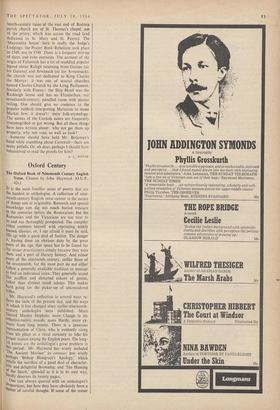Across the Tamar
Cornwall. A Shell Guide. By John Betjeman. (Faber, 15s.) JOHN BETJEMAN'S obsessive attachment to Corn- wall is very heart-warming to native Cornish folk. He has taken the place under his wing; he has written one of the best poems ever written about it in `Trebetherick,' devoted some of the most nostalgic passages of his verse-auto- biography to boyhood holidays there, and written again and again about it in prose. This book is an entire rewriting of the original edition of his Shell Guide of 1933, necessitated by the hideous population-explosion of our time—at the bottom of so many of our troubles—and the progressive ruination of the county's singular beauty.
We have been given an entrancing book, written as only Betjeman could write it, full of acute visual perception, original, eccentric, poetic, maddeningly inaccurate, mitigated bY a good deal of odd information. It is also a beautiful book, full of photographs by John Piper, Lady Elizabeth Cavendish and other mem- bers of the Betjeman troupe : they marvellously evoke the Cornish scene, with imagination and precision. Altogether they have caught the spirit of the place, if really from the outside : from the point of view of visitors to it, rather than of those born and bred there, or who live there. The book is worth twice its price.
Mr. Betjeman is at his best in describing the older towns, like Launceston, Fowey, Falmouth, Truro, Penzance (particularly good), or remote and left-behind places, like Warleggan or his favourite parish of Blisland. I have learned a great deal from the book, particularly in the visual appreciation of places or buildings, e.g., Truro Cathedral; about remote farmhouses and little old decaying manors, or the architectural work of such as William White in Cornwall. On the other hand, there are places Betjeman has not penetrated to, like the fastnesses of Newton Ferrers—a kind of lost house of Le Grand Meaulnes—with its spectacular terraces and granite balustrades, that can look like a regiment of grenadiers, in moonlight, capPed with snow. Or what about the exquisite scene of Clapper Bridge at the foot of that hill, the purling trout-stream, the two medizeval grey stone bridges?
How does the book stand up as a guide to a native? Not so Well. On practically every page there is a sentence or two about I. P. St. Aubyn's Vic- torian wrecking of church interiors, perhaps half a hundred references. This is just silly. Why doesn't Mr. Betjeman devote an essay to him some time, and get him out of his 'system? With the space gained some glaring omissions could have been filled in. Charlestown, for example—the RegencY port of St. Austell with its colour-washed 1-13_!.:. bour Terrace, and pretty Victorian chureh bowered in beeches. Perran Round should be here, most remarkable and complete of the playing places of the mediaeval miracle-plays; s°, also the fougous, the prehistoric undergrouna structures which are such a feature of West Corrl" wall. For all his acuteness of eye, Mr. BetjeMa.11 does not notice how many of the Corals!' churches occupy space within a prehistoric can1P, e.g., St. Dennis, Duloe. Not a word about the, remarkable school of slate-carvers who execute! so many fine tombs and slabs in East Cornish churches in the sixteenth and seventeenth Ott.- turies—though Pevsner mentions them, and llte,ir leading craftsman, Peter Crocker of Plymouth'
One sighs at the numerous mistakes. The four.
teenth-century ruins at the east end of Bodmin parish church are of St. Thomas's chapel, not of the priory, which was across the road (and dedicated to St. Mary and St. Petroc). The 'Mayorality house' here is really the Judge's Lodgings; the Prayer Book Rebellion took place in 1549, not in 1548. There is a frequent mix-up of dates and even centuries. The account of the origin of Falmouth has a lot of muddled popular legend about .Ralegh returning from Guinea (sic for Guiana), and Arwanack (sic for Arwennack); the church was not dedicated to King Charles the Martyr: it was one of several churches named Charles Church by the Long Parliament. Similarly with Fowey: the Ship Hotel was the Rashleigh house and has an Elizabethan, not seventeenth-century, panelled room with plaster ceiling. One should give no credence to the Popular rubbish interpreting Marazion to mean Market Jew; it doesn't: mere folk-etymology. The names of the Cornish saints are frequently transmogrified or got wrong. But all these things have been written about: why not get them up Properly, why not read, as well as look?
Someone should have held Mr. Betjeman's hand while stumbling about Cornwall—there are many pitfalls. Or, oh dear, perhaps I should have • volunteered to read the proofs for him?
A. L. ROWSE











































 Previous page
Previous page